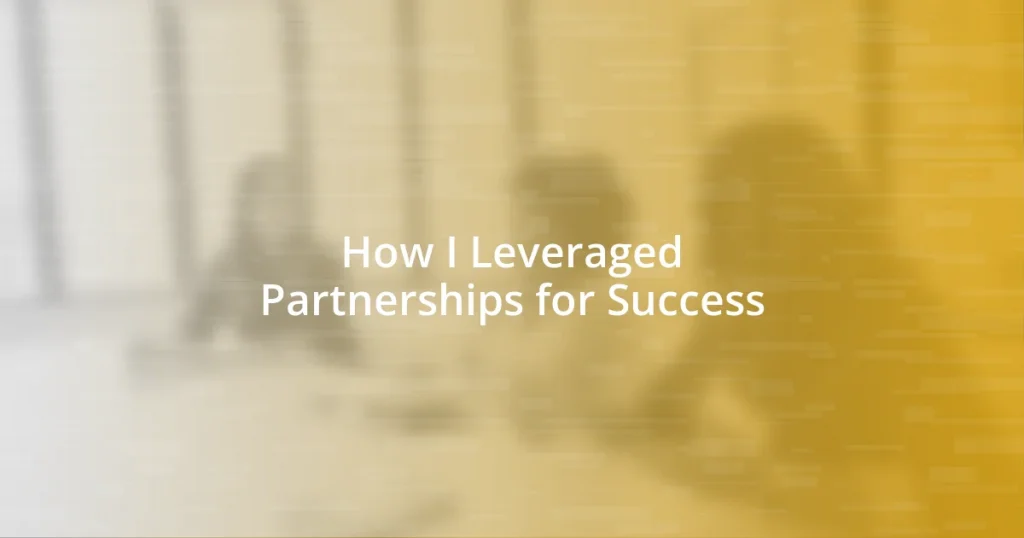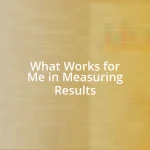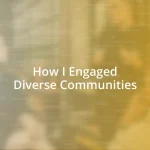Key takeaways:
- Partnerships amplify creativity and can lead to shared achievements, highlighting the importance of collaboration and emotional connection.
- Identifying potential partners involves assessing complementary skills, shared values, and leveraging existing networks to foster meaningful collaborations.
- Building trust through transparency, follow-through, and regular check-ins is crucial for the success of partnerships, along with measuring success through both qualitative and quantitative metrics.

Understanding the value of partnerships
Partnerships can transform the trajectory of a project or business in ways I never quite realized until my own experience. I still remember the moment I joined forces with a colleague whose skill set complemented mine perfectly. It made me reflect: what if I hadn’t taken that leap? Collaboration unlocked a new level of creativity and innovation for me, demonstrating just how powerful it can be to leverage diverse strengths.
The emotional journey of forming partnerships is equally significant. Every time I’ve collaborated, I’ve felt a mix of excitement and vulnerability. It’s a dance of trust—sharing ideas, risks, and rewards. How often do we pause to consider the potential of shared vision? When I’ve openly shared my goals and listened to others, I’ve discovered that these partnerships not only bring fresh perspectives but also create a sense of community and belonging that I deeply value.
Looking back, I’ve learned that the value of partnerships isn’t just in practical gains; it’s in the relationships built over time. There’s something rewarding about pursuing shared achievements together. For me, those moments of celebration with partners are the highlights of my professional journey—reminders that we’re more successful when we stand together.

Identifying potential partnership opportunities
Identifying potential partnership opportunities involves being open-minded and attuned to the talents around you. I recall attending a networking event where I casually struck up a conversation with an entrepreneur who had a different approach to problem-solving. That simple chat led to exploring ways our businesses could align, which opened doors I never expected. Recognizing those moments of connection can be the spark that ignites a successful collaboration.
To effectively identify potential partnership opportunities, consider the following:
-
Assess complementary skills: Look for individuals or organizations whose strengths fill gaps in your own abilities.
-
Explore shared values: Partnerships thrive on mutual goals and cultural alignment, so identify those who share your vision.
-
Leverage existing networks: Tap into your professional circles—friends, colleagues, and acquaintances can provide introductions to potential partners.
-
Attend industry events: Engage in workshops, conferences, or webinars to expand your network and discover like-minded professionals.
-
Utilize social media: Platforms like LinkedIn are invaluable for connecting with industry peers and identifying prospective partnerships.

Building effective partnership strategies
Building effective partnership strategies is essential for maximizing collaboration. I’ve found that laying a solid foundation can significantly boost trust among partners. For example, establishing clear communication channels early on allows everyone to express ideas and concerns freely. This openness often leads to enhanced problem-solving, as team members feel valued and heard.
Moreover, I’ve learned that developing a mutual understanding of each partner’s goals is crucial. In one of my collaborations, we took the time to discuss our visions and expectations in depth. This not only aligned our efforts but also fostered a stronger emotional commitment to the project. By ensuring everyone’s objectives were clear, we were able to craft strategies that truly reflected our shared aspirations.
The balance between structured approaches and flexibility is vital when building partnership strategies. I remember a project where we set detailed milestones but remained open to adapting them based on evolving circumstances. This adaptability kept our partnership dynamic and responsive to new opportunities, illustrating the importance of being both methodical and flexible in our strategies.
| Strategy Component | Importance |
|---|---|
| Clear Communication | Facilitates trust and openness among partners |
| Shared Goals | Aligns efforts and strengthens commitment |
| Flexibility | Adapts to changes and new opportunities |

Communicating benefits to partners
When it comes to communicating benefits to partners, clarity is paramount. I learned this during a collaboration where we crafted a joint proposal. By explicitly outlining the advantages for each party, we eliminated any uncertainty. This not only motivated my partners but also helped us all stay aligned. Isn’t it amazing how a simple conversation about what’s in it for everyone can build such strong momentum?
My experience has shown me that highlighting mutual benefits fosters a sense of ownership among partners. I once partnered with a nonprofit for a community project. We shared how their resources would enhance our outreach, while our marketing expertise would amplify their mission. This clear exchange of benefits created enthusiasm and a collaborative spirit. Have you considered how your partners might perceive their gains?
Moreover, I’ve discovered that tailoring your message to resonate with each partner’s values and goals is incredibly powerful. In another instance, I joined forces with a tech startup. By emphasizing how their innovative product could reach new customers through our established network, we ignited excitement. This personalized approach not only engaged them but also reinforced our partnership’s purpose. Isn’t that what a successful collaboration is all about—finding common ground and celebrating each other’s strengths?

Establishing trust with partners
Trust is the cornerstone of any successful partnership, and I’ve found that building it takes intentional effort. In one project, we dedicated the first few meetings solely to sharing past experiences, successes, and even failures. This transparency helped break down barriers and built a sense of camaraderie—how often do we get to see the real side of our collaborators?
One thing I’ve consistently observed is that follow-through is critical. I recall working with a partner who made a commitment to provide certain resources, and when they delivered exactly as promised, it changed the dynamic of our relationship. Trust isn’t just about what you say; it’s about what you do. When a partner consistently meets their commitments, it lays the groundwork for a relationship built on reliability.
Additionally, I’ve discovered that regularly checking in, even when things are going smoothly, reinforces trust. I remember initiating informal catch-up calls that had nothing to do with our current project, just to see how they were feeling about our partnership. This genuine interest deepened our relationship and built a rapport that made our collaborations even stronger. Don’t you agree that sometimes it’s the little gestures that make the biggest impact?

Measuring partnership success
Measuring the success of a partnership can be quite the journey, and I’ve discovered that it often requires both qualitative and quantitative metrics. For instance, during a project with a marketing agency, we set clear goals focused on engagement metrics, such as social media interactions and website traffic. Tracking these allowed us to adjust our strategies in real time, and seeing those numbers climb was incredibly fulfilling. Have you ever noticed how tangible metrics can shift a partnership’s energy?
On a more personal note, I once participated in a collaborative event where we surveyed attendees to gauge satisfaction. The feedback was eye-opening; we identified what resonated and what needed tweaking. This willingness to adapt based on direct input not only enhanced our future collaborations but solidified a sense of accountability among all partners. Isn’t it fascinating how listening to the audience can inform our partnerships?
Another way I’ve found to assess partnership success is through informal conversations post-project. I remember sharing a coffee with a collaborator after completing a major initiative. We reflected on the process and honestly discussed what worked and what didn’t. This vulnerability deepened our connection and provided new insights for future endeavors. Have you tried having these candid wrap-up discussions? They can be invaluable for your next collaborative attempt.















